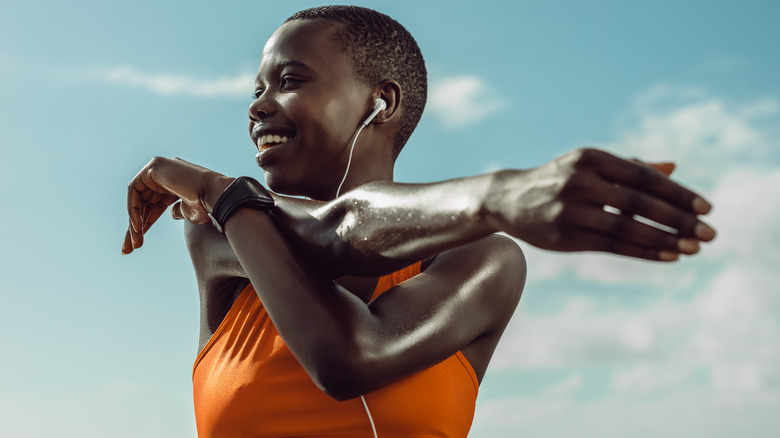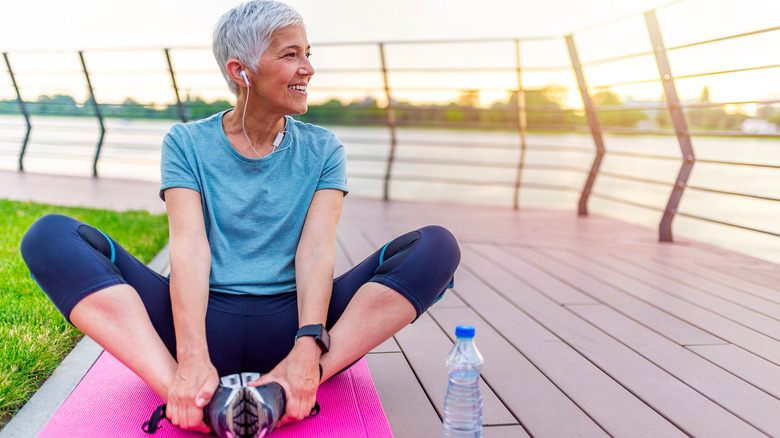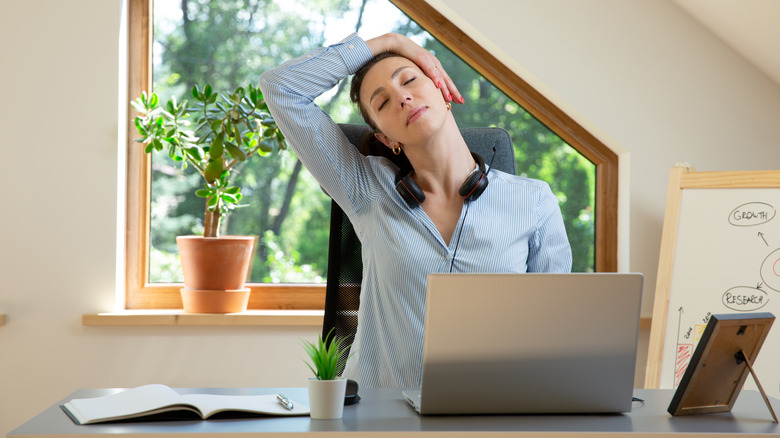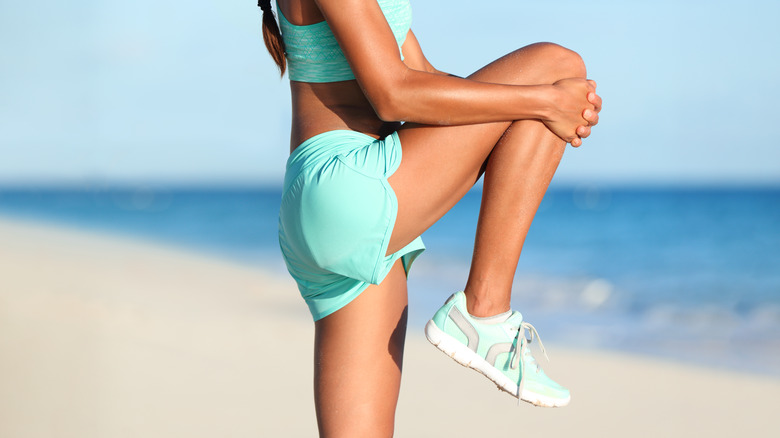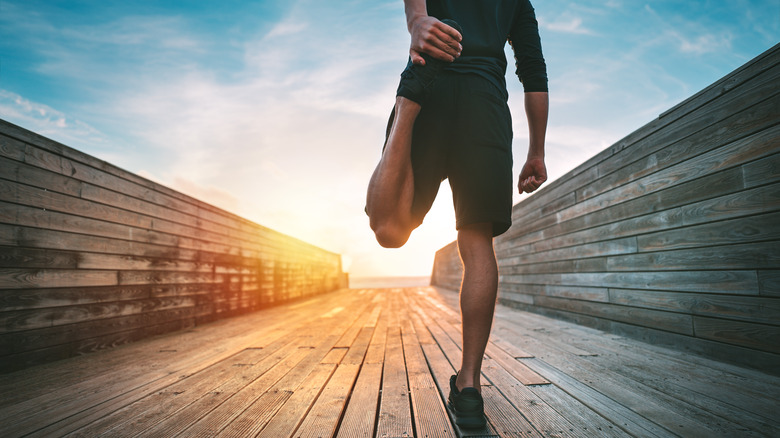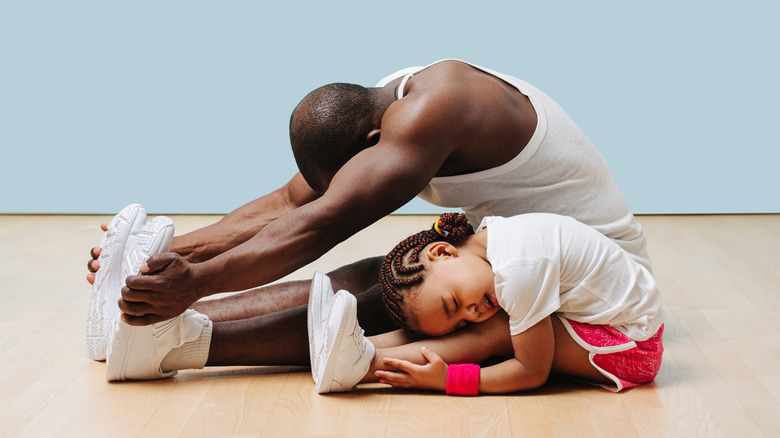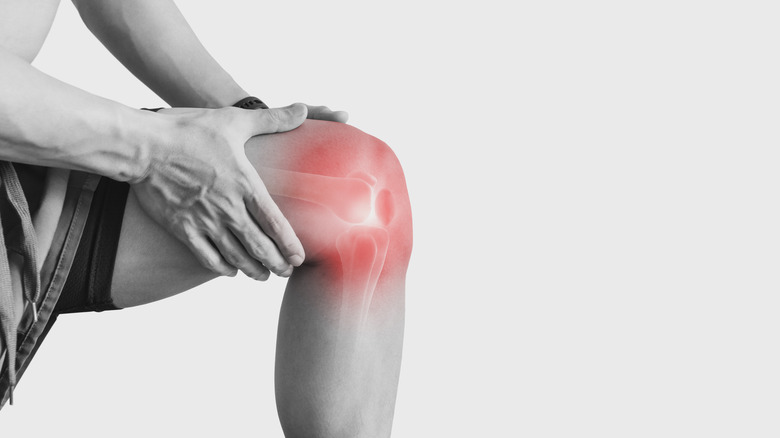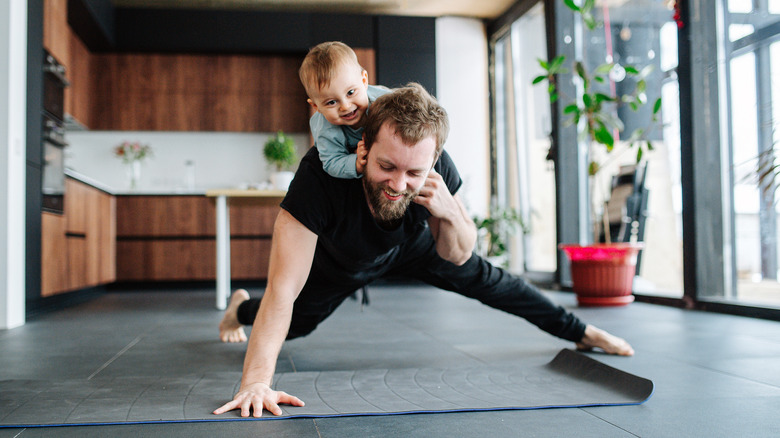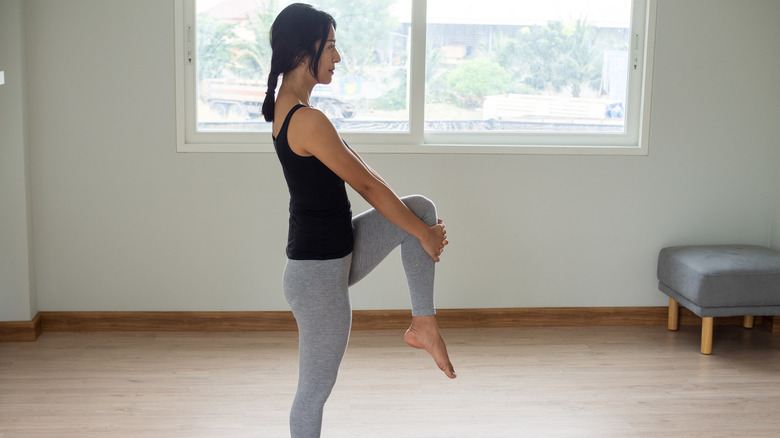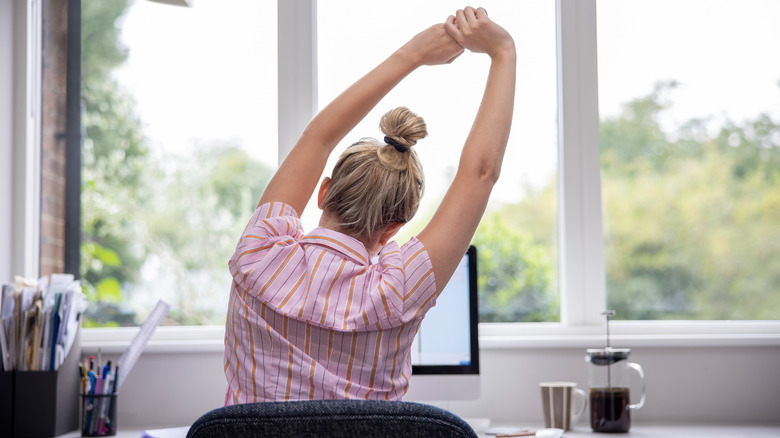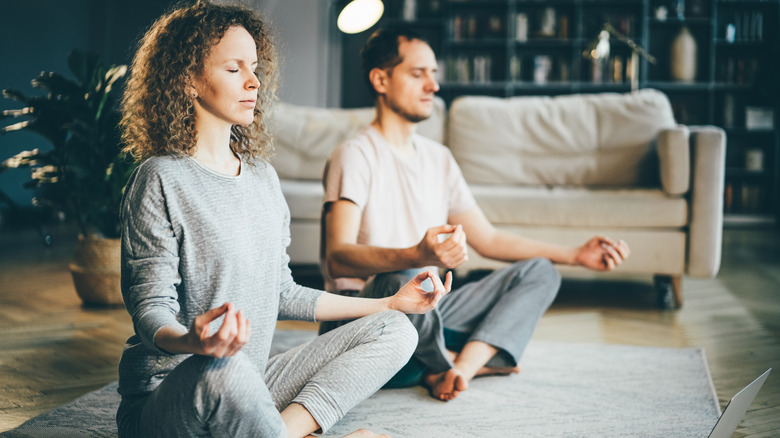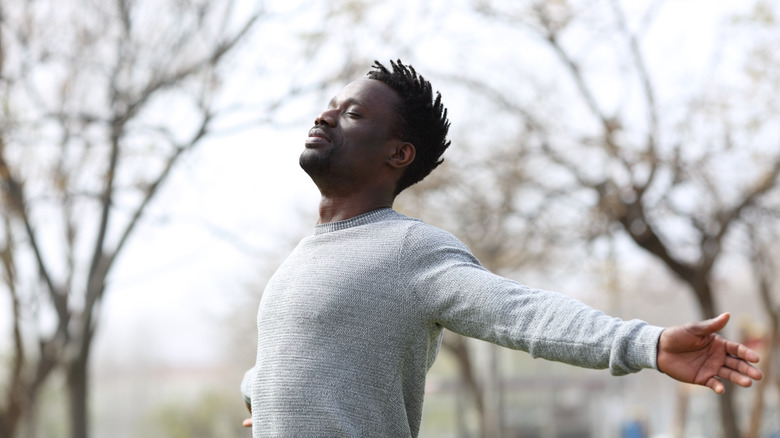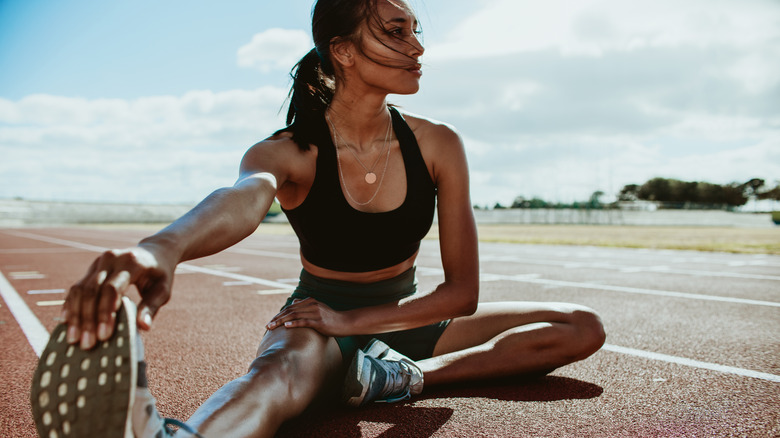What Happens To Your Body When You Stretch Every Day
Unless you're on a strict media cleanse, chances are you have seen some video clips of Olympic gymnasts soaring through the air and executing the splits high above the balance beam. While some of their skills may be impossible for laypeople like ourselves, flexibility training can have some huge physical and mental health benefits. From therapeutic exercise to yoga to the flips and dips we have seen on our TV screens, flexibility exists on a spectrum.
Even the most barebones stretching regimen can impact your posture, ease of movement, and health (via Healthline). You'd be hard-pressed to find any negative side effects of stretching every day. There are a few different types of stretching, some of which reign supreme over others. Ultimately, enjoying slow, gentle, passive stretches is the most healthful choice, per Healthline.
Read on to find out what would happen to your body if you dedicated time to stretching every day. We think you'll like what you learn.
Types of stretching
Static and dynamic stretching are the two main types of stretching that you'll see executed. Each type serves a different function. Static stretching is best performed after a workout. It consists of long, gentle holds. In static stretching, you encourage your muscle fibers to lengthen and then hold them at the endpoint of their range of motion (via Forbes). By holding a stretch for 30 seconds or longer, the muscle fibers are able to release a lot of the tension that may have been created during your workout. Though studies up until this point have been inconclusive, anecdotal evidence suggests that static stretching post-sweat-sesh can help decrease tension (per Forbes).
Dynamic stretching is best performed prior to starting your workout. It calls for engaging in repetitive movements that mimic the movements you'll be using during your workout. This style of warmup helps get muscles primed to work hard throughout their entire range of motion. Static stretching can loosen your muscles, whereas dynamic stretching helps to increase circulation and is almost necessary as part of a comprehensive warmup, fitness experts confirmed to Forbes.
The third type of stretching is known as ballistic stretching (via Healthline). It was phased out of popularity along with Richard Simmons due to the negative impacts it could have on your muscles. If you are a professional athlete under instruction from a coach, you are welcome to bounce through your stretches all day. For the rest of us, let's ensure that we stay steady and do not jolt our way through our stretches.
You'll become more flexble
Becoming more flexible may be an obvious consequence of stretching every day, but it is valuable and thus worth mentioning. Regular stretching encourages joints to move throughout their full range of motion and can soften the tense mid-bellies of our muscles. Often, tense muscles lead to imbalances and compensation which can change our posture and gaits. If left unattended for too long, these imbalances can cause chronic back pain, weakness, and other ailments (via Healthline).
If you stretch every day, you will be able to combat many of these physical ailments. Additionally, more flexibility leads to greater ease as you perform your activities of daily living, explained Healthline. Human bodies tend to lose mobility as we age, and consistent stretching is a great way to help combat this. Stretching routines also help encourage blood flow and the production of joint fluid, which aid in graceful and less painful aging. We should obviously go do some stretching right now!
Your muscles will lengthen
Stretching is, in essence, muscle lengthening. So it seems pretty obvious that stretching can lengthen your muscles. But did you know that allowing your muscles fibers to relax and lengthen can have huge benefits?
While there are many stretching-related theories floating around the exercise science sphere, it is generally accepted that stretching can lead to a decreased incidence of injury, in addition to all of the postural benefits (via Mayo Clinic). When you work out, you damage your muscle fibers by causing microscopic tears. The fibers will grow back stronger but often with more tension, explained University Hospitals. If we work to unwind this tension, our muscles stay loose. If we ditch mobility sessions day after day, over time our muscles will become especially tense. Allowing your muscle fibers to stay taut day after day can often lead to pain and postural problems
Conversely, if we work to lengthen our muscle fibers every day through stretching, we can stave off some of these postural issues. Regular stretching encourages proper alignment. It also helps you bring your joints through their full range of motion, which helps them stay healthier for longer (via Healthline).
Your range of motion will improve
When you allow your muscle fibers to tighten over time, this tension can inhibit your range of motion. Dynamic stretching in particular can guide joints through their range of motion. When done day after day, this translates into an overall increase in your range of motion (via Forbes).
Your muscles are connected to your bones via tendons, Medline Plus explained. Tendons are made of tough, fibrous material. This is generally called "connective tissue." When your muscles tighten and shorten because they are not being used throughout their full range, this can cause subtle tugging on the tendons. Over time, this tugging on the tendons can lead to joint instability. It can also change the pattern in which the joint moves (via Livestrong).
Both instability and a change in joint movement patterns can be avoided by consistent stretching. By utilizing your joints throughout their full range of motion, your range of motion will increase. An increase in range of motion leads to fewer injuries and discomfort down the line (via Forbes).
Your circulation will improve
Improved circulation is yet another benefit of daily stretching. Consistent mobility work and movement, in general, encourage blood to flow more readily through your body (via Healthline).
An increase in blood flow to your muscles means an increase in the amount of fresh oxygen they are able to utilize. This excess oxygen aids in muscle recovery. It is widely accepted that stretching after a workout helps decrease soreness. This is especially true when it comes to "delayed onset muscle soreness" or DOMS. DOMS is most frequently experienced by people who are unaccustomed to aggressive physical activities, according to the second edition of "Orthopedic Massage" (via Science Direct). DOMS usually starts to set in about one or two days after a workout, peaks two to three days in, and can often last for up to a week after a workout.
If you are about to embark on a serious fitness journey, remember to stretch after you sweat! You will improve your circulation, which will allow more oxygen to be delivered to your overworked muscles.
You will increase the production of synovial fluid
We're nerds, we get it. But stay with us because synovial fluid is super important and, trust us, you want more of it! Synovial fluid is a thick liquid that helps lubricate your synovial joints (via Verywell Health). "The different types of synovial joints are the ball-and-socket joint (shoulder joint), hinge joint (knee), pivot joint (atlantoaxial joint, between C1 and C2 vertebrae of the neck), condyloid joint (radiocarpal joint of the wrist), saddle joint (first carpometacarpal joint, between the trapezium carpal bone and the first metacarpal bone, at the base of the thumb), and plane joint (facet joints of vertebral column, between superior and inferior articular processes)," Oregon State University explained.
As we age, our synovial fluid production decreases. A reduction in joint fluid ultimately leads to rubbing of cartilage and eventually bones. However, it is possible to increase the amount of synovial fluid available in your joints through movement. The synovial membrane surrounding each synovial joint produces the fluid as a reaction to the increased circulation caused by exercising and stretching.
According to Verywell Health, stretching is actually one of the best ways to increase the production of synovial fluid. This is, fairly predictably, best when executed in conjunction with a healthy diet rich in dark leafy greens and omega-3s.
You'll get better sleep
Those of us who sleep well often take it for granted. Many struggle on a nightly basis to get the quality shut-eye that they need. Thankfully, stretching has been proven to have a calming effect, which can lead to better sleep (via Elite Daily). Gentle and intentional stretching helps prime the body for sleep by igniting restoration of the muscles. Since stretching provides your muscles with extra nutrients, via blood circulation, they are able to start the recovery process faster, according to Forbes.
Stretching before bedtime has been shown to decrease tension in the body and in the mind. Furthermore, deep breathing can help lower stress levels, which only adds to the calming effect (via Elite Daily). Instead of scrolling the 'gram before turning in for the night, spend 10 to 15 minutes doing some gentle stretches. Your body will thank you for your efforts.
Stretching can help improve your posture
It is no secret that constantly staring into our phones or computer screens encourages our bodies into bad posture. After a year-plus of working from home, you are probably feeling your spinal column starting to resemble a question mark.
One of our favorite side effects of stretching, however, is that it can aid in postural correction. Habitual avoidance of stretching can lead to shortened muscle fibers. Once your muscle fibers become shorter and tighter, the surrounding muscles can weaken. A lifetime of weak and imbalanced posture can degrade the ease in which you execute activities and it can also cause back and other joint pain (via Forbes).
By encouraging the muscles surrounding your torso to lengthen, you can also help relieve postural imbalances. By coaxing your muscles into operating as intended again, they will be more readily able to support your body, explained Healthline. Plus, stretching helps alleviate muscular tension, which often occurs in the upper back region. With spinal tension loosened, you will be well on your way to standing tall and strong with exceptional posture.
Your muscles will become healthier
With the increase of circulation stretching brings, your muscles will stay strong, healthy, and mobile (Harvard Health). Plus, increased blood flow to your muscles means more nutrients, per ShareCare. It is important to support your new stretching routine with a healthy and nutrient-dense diet. When our muscles stay loose and healthy, they are better equipped for activities when the time comes to perform them. Regular stretching prevents muscular exertion from having negative effects.
The health of your muscles becomes apparent after weeks to months of a consistent stretching routine, physical therapist David Nolan of Massachusetts General Hospital told Harvard Health. Although it would be great to see the benefits sooner, newbies should remain patient and not expect to experience major flexibility gains after only a few days. Harvard Health also urges new stretchers to do stretches every day to see the biggest benefits in the health of their muscles.
You'll decrease your risk of overuse and imbalance injuries
Some people still engage in static stretching before working out. At this point, it is widely accepted that only dynamic stretching is beneficial prior to breaking a sweat. Static stretching can actually loosen your muscles too much before a workout, which can make you more susceptible to injuries (via Harvard Health). Dynamic stretching before a workout has been proven to have great benefits when it comes to warming up (via Forbes).
By actively taking your joints through their full range of motion, you can actually decrease your risk of overuse and imbalance injuries. Dynamic stretching, in particular, can hugely aid in the preservation of balance, which is one of the first things to degrade as we age. By engaging in dynamic stretching, yoga, or Tai Chi, your balance can improve. Improving your balance can help prevent falls (via Mayo Clinic). Mobile joints offer a bit more give and can also aid in the prevention of injuries.
You may alleviate aches and pains
Similar to helping prevent injuries, stretching can help alleviate preexisting aches and pains, according to Healthline. This can happen in a few ways.
The increase in joint fluid can help lubricate the joints, which can tone down the sensations of joint pain (via Verywell Fit). Stretching daily can also help loosen muscles that have been bound up after years of hibernation. Once these muscles are reawakened, they can start functioning properly again. This is especially true when it comes to the posture-supporting muscles of the trunk (via Forbes). If your muscles are working in the ways they were intended to, the incidence of aches and pains drops significantly (via Healthline).
Another exciting benefit of daily stretching is that it can help reduce tension headaches. Tension headaches are often caused by postural imbalances and tightness through the neck and shoulders. A few minutes of stretching, a healthy diet, and lots of water may aid in the reduction of tension headaches, according to Healthline.
You may notice a decrease in stress
Better posture and spinal alignment have been proven to simply make you feel better. What starts as a physical feeling can quickly transform your mental space. According to HuffPost, there is strong evidence suggesting that the link between the mind and the body is huge. The brain tells the body how to move, but moving your body can help tell your brain how to feel. This is, in part, due to the feel-good chemicals that are released during your brain during activity.
Regularly engaging in static stretching can help alleviate emotional tension that can cause tightness in your muscles. Releasing this tension can have a calming effect on your mind. Staying present and focused on the activity at hand is another way to invoke feelings of calmness. By allowing the stress and chaos of your day to melt away while you stretch, you will feel more aligned and present (via HuffPost).
Stretching can help manage anxiety
Much like stretching can help decrease stress, it can also help lessen anxiety when performed consistently (via HuffPost). Stress and anxiety are two sides of the same coin and nearly everyone could benefit from the reduction of one or both.
Longer hold stretches are the best for anxiety reduction. This is because longer holds can lead to meditative effects. Some experts guide people to measure the time spent in their stretches by the number of deep breaths they take rather than the time on the clock. By focusing on five deep inhalations and exhalations, your mind becomes quieter and you are able to soak up the meditative effects of presence (via HuffPost).
Deep breathing whole stretching can also help you move deeper into challenging stretching. By guiding your mind and your breath, you can often encourage your muscle fibers to relax more, which can lead to bigger flexibility gains.
Your body will start to crave stretching
It kind of feels like we all have one or two yoga-obsessed friends, right? They treat it like an addiction and in some ways, it is. Human beings are naturally inclined to engage in activities that feel good and avoid activities that cause pain (via Healthline).
Because stretching feels good in the moment and allows us to feel healthy, we have a propensity to run toward it rather than away. Stretching engages the parasympathetic nervous system, releases endorphins, and improves circulation. It also helps us with our alignment, mobility, stress-management and more. In fact, when done properly, there don't see to be any negative side effects of stretching (via Healthline).
Armed with all of this information and a desire to feel our best, we are going to start a new stretching regimen. Daily stretching has been proven to have massive health, fitness, and overall wellness benefits so we are in! We hope you'll join us by stretching every day.

